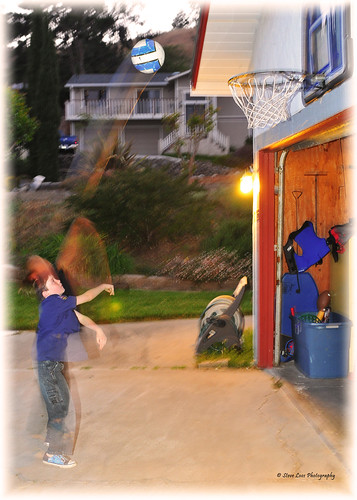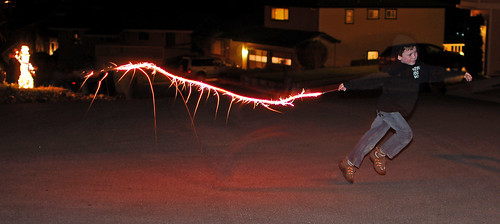slow flash, rear flash, drag the shutter, , , , huh?
Flash me baby
We all know that in dark light we need longer exposures and wider apertures to obtain a good photo, right? We also know that this will cause blurry photos because we can’t hold the camera steady and the subject of our photos tend to move. How can we use this to our advantage to create an interesting photo?
First let’s talk a bit about how we light an image with a flash and how flash works. Most modern cameras do a pretty good job of balancing light between the subject and background when using flash, but these systems can be fooled in many tough lighting situations and leave you with a dark underexposed background in your photo. The solution is to slow down the exposure as this allows more ambient light into the image; this is called “dragging the shutter.”
The slower exposure can lead to blurry photos but the flash will fire during this longer exposure and “freeze” the action of your subject.
Why can’t we just open the aperture to let in more light? Good question. Opening the aperture this will let in more ambient light but will also over exposure your subject when the flash fires. So why doesn’t taking a longer exposure over expose our subject? Most flash units fire for 1/500 to 1/1500 of a second. Whatever light the flash provides comes and goes, very fast. Leaving the shutter open for longer exposure has no affect on how much light the flash puts on your subject.
Are we in sync?
The camera must “sync” the firing of the flash with the opening and closing of the shutter. If the flash and shutter are not in sync, the image will have a funky black blurry line in the top or bottom of the image because the flash fired too soon or too late during the shutter cycle. If you have shot flash in manual mode you have seen this. Most modern cameras can sync the flash between 1/60 and 1/250 second.
The “slow sync” feature of the Nikon and Cannon cameras can sync the flash well below 1/60 second. This feature automatically slows down the shutter and correctly syncs the flash which helps add more background light to an image when using flash in dimly lit scenes. Don't worry about blurry photos - the flash will freeze the action for you, give it a try!
The “slow sync” feature of the Nikon and Cannon cameras can sync the flash well below 1/60 second. This feature automatically slows down the shutter and correctly syncs the flash which helps add more background light to an image when using flash in dimly lit scenes. Don't worry about blurry photos - the flash will freeze the action for you, give it a try!
Flash my rear!
What about the “rear sync” stuff. This is where the artsy part comes in. Remember the flash fires at 1/1000 of a second; this is why the flash will “freeze” the action even if the person is moving just as would happen in an exposure of 1/1000 second. If we take an image of a moving person for ¼ of a second the exposure will of course be blurry. When the flash fires during this exposure it will freeze the image at that instant; we will then have an image showing the blurry motion of the running person as well as the frozen image captured by the flash.
I posted this image last November for a short article on slow + rear sync. The boy is running left to right through the frame; on this long exposure if the flash fired at the beginning of the image the boy would have been at the left edge of the frame and in front of the long sparkler trail; this would have been a confusing image. Using the rear (or rear curtain or rear sync) feature the flash fires just at the end of the exposure. So, we see the bright sparkler trail moving left to right and the flash firing caught the boy to the right edge of the image at the end of the sparkler trail; this image makes sense and correctly conveys the direction and sense of motion.
Cameras that offer a "slow sync" feature also (usually) have a "slow+rear sync" feature. This slows the shutter, syncs the slow shutter, and fires the flash at the end of the image. The photo at the to of this page of the boy shooting the basketball was also taken using slow + rear sync. This is very dim evening light but notice how the houses in the background have good light? That’s due to the long exposure not the wide aperture. The flash fired just at the end of the ¼ second exposure which is why the streak caused by the basketball moving through the air is behind the basketball and not in fro
The Money Shot (you hope!)
Cameras that offer a "slow sync" feature also (usually) have a "slow+rear sync" feature. This slows the shutter, syncs the slow shutter, and fires the flash at the end of the image. The photo at the to of this page of the boy shooting the basketball was also taken using slow + rear sync. This is very dim evening light but notice how the houses in the background have good light? That’s due to the long exposure not the wide aperture. The flash fired just at the end of the ¼ second exposure which is why the streak caused by the basketball moving through the air is behind the basketball and not in fro
The Money Shot (you hope!)
The image above was taken using slow+rear flash; the exposure is 1/8 of a second and shot handheld. Notice the faces are still sharp as the flash froze any slight movement of the camera during this shot. Slow + rear flash is a great feature to try when shooting sports, dance, portraits in low lighting, or any image that is in dim lighting (works great in bright sunshine also.) Just remember that flash has as tough time lighting anything more than 10 to 20 feet away so adjust your distance to your subject if things seem a bit dim
Look for the slow and slow + rear feature on your camera and give it a try!
I live and work on the cental coast of California; please take a moment to view my website:


